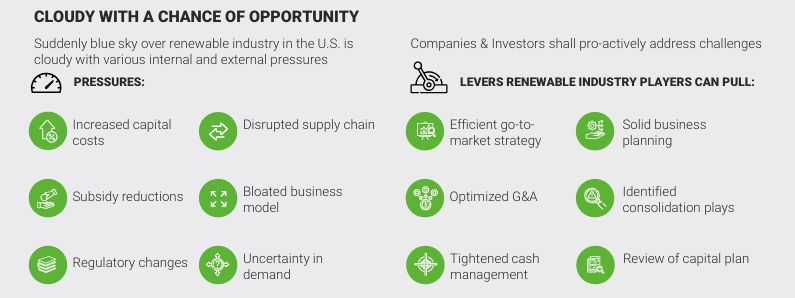The Changing Landscape Of Clean Energy After The Recent Election
November 25, 2024
Recent U.S. election results introduce new challenges and opportunities for a clean energy sector heavily influenced by the political climate, regulatory shifts, and financial markets.
United States
Energy and Natural Resources
To print this article, all you need is to be registered or login on Mondaq.com.
THE STATE OF CLEAN ENERGY AFTER THE 2024 ELECTION
Recent U.S. election results introduce new challenges and
opportunities for a clean energy sector heavily influenced by the
political climate, regulatory shifts, and financial markets. As
myriad fundamentals — including the cost of capital and policy
– evolve, so too will the sector’s growth prospects.
Investors seem to be extremely cautious about the potential
impact on the renewable sector. A representative set of publicly
traded industry leaders are underperforming the broader market in
response to the election.
AlixPartners Power & Renewables Team offers a subjective
view on changes to come and how to best prepare business for the
shift of power in Washington.
REPRESENTATIVE PRICE RETURN (INDEXED FROM
31-OCT)

SIX KEY IMPACTS ON THE RENEWABLES INDUSTRY
1. HIGHER RISK PREMIUM DRIVEN BY POLICY
UNCERTAINTY
Clean energy projects are capital-intensive, and this changing
of the guard may result in slower-than-expected interest rate
declines. At the same time, potential policy shifts could drive up
borrowing costs for renewable investments. Even though the
Inflation Reduction Act may not be fully repealed, there is still
considerable legislative risk to clean energy programs in the wake
of the election.
Any changes to the IRA provisions could disrupt the flow of
subsidies and tax credits, making it harder for companies to access
capital. Smaller clean energy firms are especially vulnerable to
financial difficulties if government loans or subsidies are delayed
investors should be prepared for disruption across the renewable
supply chain.
With possible higher risk premiums driven by uncertainty ahead,
companies should immediately explore alternative funding
strategies, tighten cash management, and scrutinize capital
projects. Companies dependent on federal loan commitments or
subsidies should prepare for potential setbacks, while larger firms
may need to focus on accelerating projects before funding sources
dry up.
2. SHORT-TERM SCRAMBLE FOR KEY COMPONENTS
Those anticipating higher tariffs and a tougher regulatory
climate may rush to start clean energy projects before changes to
subsidies and credits take effect, or deadlines for existing tax
incentives are accelerated. A short-term demand surge would further
pressure supply chains, creating near-term upward pressure on
prices for key components.
Swift action is required to secure supplies and meet deadlines
tied to current incentives before new tariffs take effect.
3. ONSHORING AND NEARSHORING MAY INTENSIFY
Trade policies are in flux, with tariffs and geopolitical
tension affecting Asian supply chains and potentially fueling a
more aggressive shift to nearshoring. Focus may shift to building
resilient production closer to home or within allied nations,
helping avoid disruptions and ensure stability.
This significant shift in supply chain and potential need to
develop new manufacturing capacity requires a deep review of
internal capabilities resulting in realignment of the operating
model to enable success.
4. SUBSIDY AND LOAN DELAY, CHANGES IN IRS
GUIDELINES
Election results are stoking concern about potential delays in
grants, loans, and tax credits. The processing of support from the
Department of Energy’s Loan Programs Office may slow down, for
instance, impacting firms dependent on government assistance.
The Trump administration’s approach to the Waste
Emissions Charge – the source of revenue for the IRA tax
credits – should be closely watched. Changes to IRS
guidelines on tax credit rules would make it harder for companies
and consumers to claim credits for renewable energy technologies
like solar and electric vehicles. This could dampen the growth of
these markets, slowing investment and reducing the attractiveness
of clean energy projects for consumers.
Business models heavily dependent on governmental programs may
want to reassess economic viability of their projects, revise
growth plans and profitability assumptions in the business plan.
Organizational rightsizing may be required to adjust cost base to
the new normal.
5. RE-ALIGNMENT TO LOCAL INCENTIVES
While the federal government has clout via many general tax
credits, each state will work to fortify their own energy policies.
The already significant divide for ISOs deploying more renewable
generation (CAISO; SPP, ISO-NE) may further deepen driven by local
incentives and weakened federal policy. States pushing more
renewables will shore up local incentives to meet the energy
transition targets.
Regionalization of incentives will widen the gap in energy
deployment, perhaps causing more shift in business footprints over
the next four years. Companies must rethink its go-to-market
strategies to best position their businesses to capitalize on local
incentives. This shift may add further complexity to the business
and drive short-term uncertainty. True winners will be able to
re-align their geographic focus and accelerate growth through
selective M&A.
6. DEREGULATION OPPORTUNITIES
Deregulation is likely to continue, potentially including repeal
of environmental reviews and attempted dismantling of the EPA.
Improved economics for fossil fuels may not be enough to attract
more investments as clean energy already competes without subsidies
in many markets. Historical EPA regulations (Clean Air Act and
Clean Water Act) will be difficult to dismantle due to history and
entrenched processes and will likely remain intact.
If certain environmental protections are rolled back, however,
this could streamline project approval timelines and reduce
bureaucratic hurdles, allowing companies to bring products to
market faster. For clean energy projects like solar farms and
energy storage systems, shorter approval timelines could
significantly speed up deployment and reduce costs.
Companies should explore opportunities to capitalize on less
strict regulatory environment. As the economics of many businesses
shift, legal, regulatory and permitting may be areas of substantial
savings if managed properly. New, possibly compressed timelines and
lower third-party spend may offer much needed tailwind to the
already challenged capital projects in renewable space.

The content of this article is intended to provide a general
guide to the subject matter. Specialist advice should be sought
about your specific circumstances.
Search
RECENT PRESS RELEASES
Related Post


